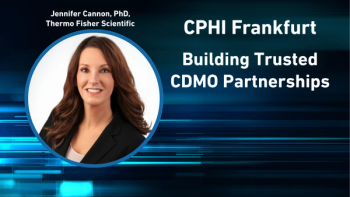
- Pharmaceutical Technology, June 2023
- Volume 47
- Issue 6
- Pages: 16-18
The Outsourcing Success Story
What factors do CDMOs consider vital to their success?
In a competitive outsourcing market, contract development and manufacturing organizations (CDMOs) are always searching for the best ways to serve their clients. CDMOs and other contract organizations will look to industry to determine where they should invest in their services and facilities, and successful CDMOs will pivot to meet industry needs.
In this vein, successful CDMOs are perhaps one of the best sources for insight into trends not only into the outsourcing sphere, but the entire pharma industry. This article will explore the factors CDMOs view as important in landing pharmaceutical clients, and what one can infer regarding the state of the industry from them.
End-to-end manufacturing and flexibility
A stray observer attending just about any pharma conference would likely be struck by a phrase CDMO representatives seem to repeat again and again: end-to-end services. In Pharmaceutical Technology®’s coverage of the 2023 DCAT conference alone, representatives from Thermo Fisher Scientific (1), CordenPharma (2), and Quotient Sciences (3) stressed that their company offered end-to-end services. Sarah Stevens, senior vice-president and head of Drug Product Development & Manufacturing at Quotient Sciences at the time of the interview, even made the case that we would see this marketing increase further over the course of the next few years.
“Thinking about it from the CDMO and pharmaceutical services perspective, I think we will see this continuing direction of travel towards offering a fully integrated end-to-end service,” said Stevens (3). “I think almost all CDMOs will be at least claiming to offer integrated, end-to-end services.”
In large part, end-to-end services are receiving abundant attention because they satisfy two interconnected core criteria: supply chain anxiety and flexibility. Existing issues of the just-in-time supply chain model were shattered by the COVID-19 pandemic, leaving manufacturers who were dependent on multiple companies in multiple countries for different steps of the drug development, manufacturing, and packaging process scrambling to maintain their manufacturing processes (4).
This situation presented CDMOs with a unique opportunity: companies offering both drug substance and drug product services could now pitch themselves on the virtue of supply chain redundancy, which was now in demand. While this hasn’t necessarily been entirely transformative—many CDMOs, in particular small-to-mid sized operations, will almost certainly continue to specialize in certain steps of the manufacturing process—it has become an increasingly viable way to get one’s foot in the door. And should the pitch land, it presents a stronger value proposition for the CDMO, as they have the added leverage because they are more deeply integrating themselves into their partner company’s operations.
However, as Stevens somewhat alluded to in her quote, an end-to-end service needs to satisfy the many complex needs of its partner company. While many companies advertise their end-to-end capabilities on paper, they often do not have the existing capabilities to serve all potential clients. In a DCAT roundtable on the topic, Enrico Polastro, vice-president and senior industry specialist, Global Pharmaceutical and Fine Chemicals Practice, Arthur D. Little, noted that end-to-end companies are “unlikely to be able to offer the full range of molecule building and formulation capabilities covering the entire spectrum of pharmaceutical products” (5).
This is where manufacturing flexibility comes into play. While it is difficult to cover the full spectrum of needs, the more one can offer, the more enticing that becomes to potential clients, as it allows the partner company to operate more broadly and trust that changes can be made on the backend to accommodate any necessary changes. Furthermore, establishing a relationship with an outsourcing company that can address various needs may be desirable for companies who anticipate expanding into various types of drug products, as it gives them the option to return to a familiar process that has previously addressed their needs.
“Outsourcing partnerships that prioritize flexibility enable companies to quickly adapt to market changes,” says Nandu Deorkar, senior vice-president, Research & Development, Avantor. “In a fast-paced industry like pharmaceuticals and biotech, market demands can change rapidly, and companies that can quickly adapt have a competitive advantage. By having a flexible outsourcing partner, companies can adjust their operations promptly to meet changing market demands and stay ahead of the competition.”
This flexibility can take many forms. For instance, according to Deorkar, manufacturing agility, scalability, and collaboration are all crucial factors, in addition to technical expertise and demonstrated capability. Ultimately, what is crucial is starting a dialogue that enables an outsourcing company to efficiently and capably respond to the needs of its partner; end-to-end capabilities are one such answer in the current broader pharmaceutical market.
Steering into sustainability
Another corporate structure that has received increased attention among CDMOs is the push toward sustainability operations. On the surface, this move works well purely from a public relations perspective; a 2021 Pew Research study found that 80% of respondents in 17 advanced countries were willing to make “a lot” or “some” changes to how they lived or worked in order to fight climate change (6). Even as it pertains to the United States, which has historically fought over the issue, as of April 2023 69% of Americans believe the country should invest in renewable resources and strive toward carbon neutrality by 2050 (7), and the United States government has passed major legislation geared toward energy sustainability (8).
“Outsourcing companies are placing an emphasis on their sustainability practices to showcase their commitment to social responsibility, which can also improve their reputation and brand image,” says Deorkar. “Consumers are becoming more aware of environmental issues, and they prefer to purchase products and services from companies that prioritize sustainability.”
All that said, while the preferences of the general public should be noted—particularly as public opinion places a key role in shaping legislation—their direct impact on business-to-business interactions is difficult to directly
link. However, an understated impact of sustainability measures is in how they confer an economic benefit to businesses that use them.
For instance, in a video interview with Pharmaceutical Technology, Pierre Luzeau, CEO of Seqens, an outsourcing company specializing in pharmaceutical synthesis and specialty, noted that customers were specifically looking for partners who could help them reach sustainability goals like carbon-zero (9). Luzeau argued that it was such a strong factor in business decisions that failing to hit that benchmark, or at least work toward it, could be a death sentence.
“We are convinced that the selection of suppliers will be based on the best supplier from that standpoint,” said Luzeau. “If you are not capable of proposing the best solution as far as [corporate social responsibility] is concerned, you will disappear in the 10 years’ timeframe—this is for sure.”
The economic reasons for this are multi-faceted. First, as public opinion continues to favor environmental sustainability measures, the likelihood of government-subsidized energy programs and fines for energy inefficient processes rises. Companies that cannot get ahead of anticipated regulations in a timely manner will be deemed more inflexible in that regard than their competitors.
From a strictly cost-savings perspective, energy initiatives reduce energy consumption and waste. Sustainability and efficiency are inextricably tied, and there are measurable savings that occur from energy and waste reduction.
For example, while the fixed costs on solar panels are significant at the beginning, with enough time one can recoup those costs and more. Furthermore, anticipated advances in energy-saving technology could pave the way for “alternative energy” to simply become “energy,” as Jason Lomberg, North American editor at Power System Designs, succinctly notes in “The Elusive ‘Break-Even’ Point for Alternative Energy.”
“In the very near future, solar—and other technologies with an unforeseen ‘break even’ point might shed the ‘alternative’ label and just be an extremely viable form of energy,” said Lomberg (10).
The complicated question of cost
While this article has tackled what CDMOs are placing an emphasis on, one might notice one factor that is not being discussed: cost. In many private sector negotiations, regardless of other qualifications, the lowest bid often gets the job. However, pharma marketing tends to steer clear of this topic—no CDMO is publicly advertising themselves as a “budget” option.
There are multiple reasons for this. George Ntortas, partner at Fuliginous Management Consulting, a consulting firm that works with companies operating in the CDMO space, neatly summarized the inherent variability of the CDMO pricing structure in a feature he wrote on LinkedIn. In the feature, Ntortas explained that various factors, including the type of manufacturing being performed, the degree of difficulty of the task, whether competitor’s have similar capabilities, and dozens of others all impact price in some form or fashion. Production for a generic paracetamol tablet might only need to be
sold at a 60% mark-up, whereas lyophilized patented vial may be in more of a ballpark of 90% (11).
“Margin is not the only factor affecting what is the willingness of a pharma company to pay. Culture, location, quality, cooperation, responsiveness, and flexibility of the CDMO also affect customers’ willingness to pay,” said Ntortas. “If the pharmaceutical company is satisfied with the service level they get from a CDMO, if they feel that they are important and their supply is secured, they are probably ready to sacrifice part of their margin as opposed to choosing a CDMO with a lower price but also a lower service level and higher supply risk.”
It is because of the inherent variability of the types of projects, customers, and deadlines that CDMOs deal with that leads to cost differentials. If a CDMO were to advertise itself at one price, it would almost certainly be wildly overcharging or undercharging most of its clients; either way, it would soon be out of business. While cost might not be pushed to the forefront of marketing, it is still very much a consideration—but it is one that is dependent on variables that need to be ironed out in negotiations.
“While cost is undoubtedly an essential factor to consider in outsourcing partnerships, it should not be the sole focus,” says Deorkar. “Successfully bringing a drug to market or clinic requires more than just cost reduction. Technical expertise, scalability, and flexibility are also crucial capabilities that can significantly impact the success of an outsourcing partnership. Companies may sidestep cost discussions in public because it’s a sensitive topic, but it’s still an important consideration in the decision-making process.”
References
1. Playter, G. Discussing the Growing Role of CDMOs with Anil Kane. PharmTech.com, March 29, 2023.
2. Playter, G. Illuminating the State of Outsourcing with Stephen Houldsworth. PharmTech.com, March 27, 2023.
3. Playter, G. Exploring the Future of Outsourcing with Sarah Stevens. PharmTech.com, April 28, 2023.
4. Spivey, C. Drug Solutions Podcast: Securing Manufacturing Independence Through Re-shoring Facilities to USA. PharmTech.com, March 1, 2022.
5. DCAT Value Chain Insights. Straight Talk: End-to-End CDMO/CMO Business Models. dcatvci.org, July 24, 2019.
6. Bell, J.; Poushter, J.; and Kennedy, B. In Response to Climate Change, Citizens in Advanced Economies Are Willing To Alter How They Live and Work. pewresearch.com, Sept. 14, 2021.
7. Tyson, A.; Funk, C.; Faigan, M.; and Huang, C. What the Data Says About Americans’ Views of Climate Change. pewresearch.com, April 18, 2023.
8. H.R.5376, US House of Representatives, 117th Congress, 130th Session (Washington, DC), Sept. 27, 2021
9. Playter, G. Setting Sustainability Goals with Pierre Luzeau. PharmTech.com, March 30, 2023.
10. Lomberg J. The Elusive “Break-Even” Point for Alternative Energy. powersystemdesign.com, May 30, 2017.
11. George Ntortas. Pricing in the Pharmaceutical CDMO Environment. linkedin.com, July 29, 2020.
About the author
Grant Playter is associate editor for Pharmaceutical Technology.
Article details
Pharmaceutical Technology
Vol. 47, No. 6
June 2023
Page: 16-18
Citation
When referring to this article, please cite it as Playter, G. Governance of Future Pandemics. Pharmaceutical Technology 47 (6) 2023.
Articles in this issue
over 2 years ago
Facing the Future of Aseptic Manufacturingover 2 years ago
Planning the Future of Pharma at CPHIover 2 years ago
EMA Overhauls the Medicine Legislative and Regulatory Frameworkover 2 years ago
The Swiss Appealover 2 years ago
Overcoming the Poor Solubility of Cannabinoidsover 2 years ago
Impurities Testing of Drug Productsover 2 years ago
FDA Eyes New Strategies to Spur Gene Therapy Developmentover 2 years ago
Strategies for Contamination ControlNewsletter
Get the essential updates shaping the future of pharma manufacturing and compliance—subscribe today to Pharmaceutical Technology and never miss a breakthrough.




